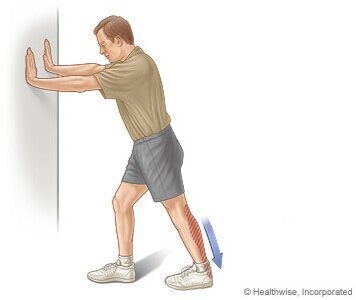Stretching is overlooked too often even though it is valuable to our well being. It is one part of total wellness that can help you live a healthier and more productive life. Establishing a routine will help you be successful in your stretching endeavors and minimize or eliminate many of the aches and pains caused by the modern work environment.
Here are some of the most important, yet easy to do at work, stretches that everyone needs in their lives. Each of these stretches prevent conditions that can disrupt your work life. So I've also included my personal schedule of when to do them so they stay in your life. Adopt it as your own or re-organize to meet your needs.
The goal is daily care for physical demands you place on your body. Take note of how they will improve your daily life and share it here in the comments - who knows, you could inspire others to be healthier and happier with your own experience!
Hip Flexor
By now, it should not be a secret, this muscle group has a role in much of the aches and pains we experience in today's society. Consider them as "sitting muscles". While you don't consciously use them while you sit, they are shortened because of the incredible amount of time we spend in a seated position. This lack of physical attention can contribute to lower back pain. Think of all the time dedicated to things you do seated - commute to and from work, work itself, meetings, travel, TV at home and more. There are plenty of reasons why this type of stretch is so important.
Hip Flexor
Desk Stretch
1. Start at a half-kneeling position.
2. Place hands on top of desk or support object.
3. Squeeze glutes and pull in core.
(think of pushing your hip against resistance)
4. Press down on desk or support.
*Avoid arching your lower back.
In a successful stretch, you will feel tension in front of your thigh and hip.
Image credit to https://myphysiosa.com.au
Chest
Here is another key stretch! We use this muscle group often too. The muscles of the chest are responsible for bringing and keeping your hands and arms in front of you. You will notice rounding of the back and shoulders when these become far too tight. It can also cause numbness and coldness of fingers and hands by compressing blood and nerve bundles. Admittedly, stretching is only one portion of this. Balancing our strength, posture, and movement habits are also necessary - stick around for this in a future blog from me.
Open Chest Stretch
1. Sit up straight and tall in your chair.
2. Open your arms wide to make a T shape with your body.
3. Repeat again to make a Y shape with your body by raising your arms slightly overhead.
4. It is important to keep your thumps pointed up toward the ceiling.
Neck
The last of the three most important relevant stretches in our lives - is now becoming an epidemic of sorts. It goes by many names. Newly termed Text Neck, or my personal term iPosture, really is degenerating our health at a slow, near imperceptible pace. It isn't confined to use of mobile tech - poor ergonomics in every area of life can contribute. Especially at the office! But through these stretches, you can trade your aches for happier, healthier work or play. In extreme cases I have seen disc bulges with neurological symptoms caused by poor posture habits.
Gentle Neck Stretch
1. Facing forward, place a hand on top of your head with the fingers just above and behind your ear.
2. Tilt your head toward your raised arm creating tension on the neck muscles.
3. Only use gentle pressure, about the weight of your hand.
4. To increase the intensity of this stretch, begin by grabbing the chair seat with your free hanging arm.
5. Repeat this stretch with your head tilted forward and down to target different muscles.
This will not be the last time I warn about poor posture leading toward problems. So, with consistent and regular use of these stretches, it is my hope those concerns won't apply to you in the future.
BONUS
The following muscles groups are closely associated with those mentioned above. A stretching equivalent to dental flossing. These will support a more complete approach to your health routine through stretching.
Hamstring
Similar to the hips, these are affected by our time spent sitting. They also find themselves doing work meant for other muscles, but I will discuss this in future articles.
Standing Hip Hinge Hamstring Stretch
1. Begin in a standing position.
2. Place one foot out in front of you with the heel on the ground and the toes pointed up.
3. Bend the opposite leg at the knee to feel the stretch while keeping your back straight by allowing your hip to hinge.
4. Placing your hand on your hips may also help you maintain good posture during the stretch.
Image credit to https://www.nhs.uk
Forearm
The majority of muscles used for hand motions exist here in the forearm. If you are experiencing numbness and heavy arms when you wake - take immediate action to care for these muscles as they may be the culprit. You’ll be thanking yourself with these for actively stretching to dodge carpal tunnel syndrome.
Forearm Table Top Stretch
1. Find a suitable flat, stable surface to begin with that at or below the level of your wrist while standing upright.
2. Place one or both hands on the desk so that the fingers are facing your body.
3. Start with your shoulders in front of your wrists, increasing tension by shifting your upper body in the direction of your fingers. Do not compress the wrist.
Lower Leg
Similar to the hands, a number of muscles that move the feet (primarily walking and driving) are in the lower leg.
Standing Hamstring Stretch
1. Using a wall or stable fixture, begin by taking a step backward.
2. Straighten the back leg by extending the knee, pressing your heel down into the ground.
3. Shift your hips forward to increase the stretch.
As promised - A simple daily guide to these important stretches. Takes breaks from you desk work to do these stretches several times throughout the day. As your routine improves, you may not need to stretch more than once or twice a week.
Now, if your aches and pains see no signs of improvement or are getting worse - it is time to see a doctor. There is chance that one or more joints in the body is not functioning correctly and needs to be corrected by a chiropractor. If there is more going on under the surface your chiropractic doctor can help direct you to appropriate care.
Also, If you'd just like some personal guidance and help getting the stretches down or would like to take care of your aches and pains quicker, through more advanced anatomical stretching techniques that are not possible to do on your own - advocate to your company to have an onsite chiropractor through AlignHQ or reach out to us by email to set up a telemedicine appointment.







